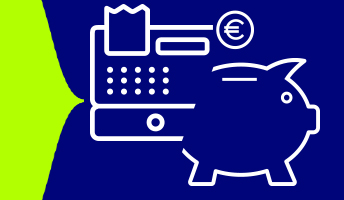Money Smarts Challenge Teacher Guides
1. Spending & Saving Teacher Guide
Spending & Saving
This is the first of six pillars of Financial Wellbeing. The following information shows your students how to be a smart spender and develop healthy habits when it comes to saving. The content is designed to give you a flavour of what you can expect your students to be quizzed on as part of the Money Smarts Challenge.
This pillar has been specially crafted to remind your students of the importance of balance in life. While we all need to live in the moment and enjoy everything on offer, they also need to be prepared financially for the future. That way they can deal with any little surprises, big or small, that life throws up along the way.
Topics
| Spending | Saving |
|---|---|
| Budgeting and record-keeping tips The simple 50/30/20 saving and spending rule Needs versus Wants | Budgets and spending to a budget Saving goals Rainy-day funds |

2. Earning & Income Teacher Guide
Earning & Income
This is the second of six pillars of Financial Wellbeing. The following information shows your students the various ways in which money can be earned, while also highlighting some non-earned ways people secure an income. The content is designed to give you a flavour of what you can expect your students to be quizzed on as part of the Money Smarts Challenge.
Tax, as they say, is just one of those inevitable things in life. While everyone has to pay it, it’s not always easy to understand. This pillar has been specially crafted to help them understand it better and looks at tackling tax, breaking it down and exploring the differences between gross and net income in the context of a payslip.
Topics
| Earning | Income |
|---|---|
| Earned v Unearned income Facts about earning an income How do people earn money? | What do the numbers mean How taxes are applied How to read a payslip What the acronyms mean on the payslip The difference between gross pay and net pay |

3. Credit & Debt Teacher Guide
Credit & Debt
This is the third of six pillars of Financial Wellbeing. The following information shows your students the difference between credit, the money available to be borrowed, and debt, the money that has been borrowed. The content is designed to give you a flavour of what you can expect your students to be quizzed on as part of the Money Smarts Challenge.
With a variety of lenders operating in the UK Market, there are many different types of credit options available, from loans to credit cards etc. This pillar has been specially crafted to help students better understand their options. As well as highlighting some of the costs associated with accessing credit, it outlines some top tips on being credit clever and managing debt responsibly.
Topics
| Credit & Debt |
|---|
| Understanding credit and debt Evaluating interest charges and the cost of credit Evaluate loans and different loan options |

4. Investing Teacher Guide
Investing
This is the fourth of six pillars of Financial Wellbeing. The following information shows your students the benefits of investing when they have a long term financial goal in mind. The content is designed to give you a flavour of what you can expect your students to be quizzed on as part of the Money Smarts Challenge.
The primary reason people invest is for the promise of a higher rate of return on their money than would be possible by just keeping it in a savings account. However, investing money involves varying amounts of risk. This pillar has been specially crafted to help students consider these risks and provides a basic understanding of investment markets.
Topics
| Investing |
|---|
| Explain what investing is Recall the key components of the investment hierarchy Explain what stocks are Differentiate between stocks and bonds Interpret investment news and how world events impact investments |

5. Risk & Protection Teacher Guide
Risk & Protection
This is the fifth of six pillars of Financial Wellbeing. The following information discusses the issue of risk and shows your students how to develop strategies to protect against it. The content is designed to give you a flavour of what you can expect your students to be quizzed on as part of the Money Smarts Challenge.
Risk is everywhere. Most people will face a variety of risks, including financial risks, throughout their life. Some risks can, and will, present major financial challenges. This pillar has been specially crafted to help students consider these risks. It provides important information in relation to the knowledge and skills needed to asses risk and minimise its impact.
Topics
| Risk & Protection |
|---|
| Fraud Vishing Smishing Phishing life events (health etc.) Twishing Money Mules Top tips for banking online |

6. Financial Decision Making Teacher Guide
Financial Decision Making
This is the sixth of six pillars of Financial Wellbeing. The following information discusses the concept of personal financial planning, which we sometimes refer to as Financial Decision Making. The content is designed to give you a flavour of what you can expect your students to be quizzed on as part of the Money Smarts Challenge.
In order to make sound financial decisions in life, one must integrate various aspects of each pillar as they arise or are required. For example, where one is considering using some of their income to invest for the future, they will need to factor in net income along with spending habits as well as risks associated with certain forms of investing. This crucial pillar has been specially crafted to help students make sound personal financial decisions in life.
Topics
| Needs and Wants | Goal Setting and Budgeting |
|---|---|
| Students will learn to evaluate and prioritise. | Students will learn to formulate, construct and manage a goal setting plan and how to use a personal budget planner. |
